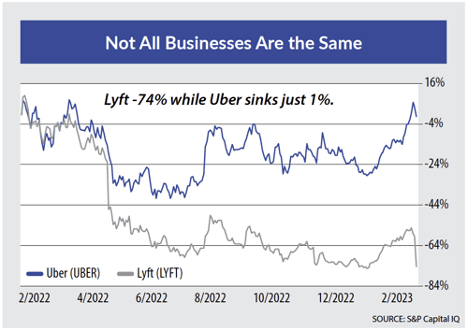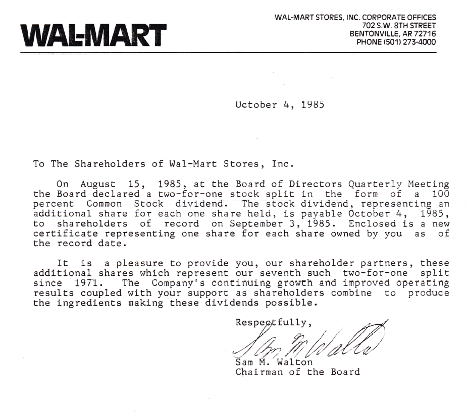Andrew Jackson said: “One man with courage makes a majority.”
Throughout my life, I’ve seen the impact that one person can have.
Especially when it comes to leading a company.
Wall Street believes the CEOs are like lightbulbs … interchangeable.
That’s not the way I saw it.
In fact, many investors can’t even name the CEO of their largest holdings!
That always struck me as being a bit crazy.
How could one NOT research the person that is running the business, setting the strategy, allocating the capital?
Especially when that person can have the biggest impact on your stock returns.
If you partner with great CEOs, it’s pretty hard not to make money over the long term.
That’s what attracted me to Uber Technologies Inc. (NYSE: UBER) back in 2017 — when Dara Khosrowshahi became CEO.
At the time, Uber was already the world’s leading rideshare app.
However, the business was out of control.
The #DeleteUber movement had just cost them 200,000 passengers…
Former engineer Susan Fowler had written a bombshell blog denouncing the company’s culture…
And lawsuits were pouring in — forcing the former CEO to step aside before a new leader could even be appointed.
And that’s when Khosrowshahi stepped in as CEO and started cleaning house.
It was messy, but the business slowly turned around at Uber.
Thanks in large part to him…
Supercharged CEO
Prior to joining Uber, Dara Khosrowshahi was CEO of Expedia since August 2005. Under his leadership, bookings more than quadrupled … and its earnings more than doubled.
Expedia’s stock price had soared more than 600% — close to four times the S&P 500’s gain while Khosrowshahi was CEO.
The thing about great CEOs … they are able to replicate their success in other industries.
And that’s just what he’s done.
Since becoming CEO of Uber, he’s transformed the corporate culture, optimized operations and focused on generating free cash flow.
Unlike its main competitor — Lyft Inc. (Nasdaq: LYFT) — Uber doesn’t just offer rideshares. They also have UberEats, a contactless delivery for restaurant takeout.
UberEats gives drivers two ways to make money. When the rideshare business is slow, they can deliver UberEats.
This is a big factor for attracting new drivers to the company.
It has also helped increase Uber’s share of rideshare from 62% in early 2020 to 74%.
Meanwhile, Lyft’s market share fell from 38% to 26%.
The company’s performance makes the case even stronger that not all businesses in one industry are alike.
In February, both Uber and Lyft reported earnings a few days apart.
Uber ended its strongest quarter ever, capping off its strongest year.
Lyft reported a few days later … lower revenue, lower guidance and flat rideshare growth.
The stock price of both companies speaks volumes as to the performance of their businesses over the past year:
Obvious Differences
Uber and Lyft have most of the market share for the rideshare industry.
Yet one of them has 3X the market share of its competitor and made a profit, while the other is pretty close to being on life support.
And the biggest difference between them are the people in charge.
Lyft has always been run by founders Logan Green and John Zimmer. Both men are tech industry dreamers who hit it big with their rideshare app.
But couldn’t execute when it came down to running the business.
Meanwhile Khosrowshahi has spent the last six years leading Uber from the front … seat, literally.
Last September, Uber was seeing a slowdown in driver recruitment.
So Khosrowshahi went from behind his desk to the front seat of a used Tesla.
He worked as a driver undercover as “David K.,” picking up roughly 100 fares.
He wanted to fully understand the drivers’ experience firsthand.
Khosrowshahi realized the drivers’ complaints were valid, and is now working on the problem.
After years of making grandiose promises about the future, Lyft’s founders have announced their stepping down as president and CEO.
Meanwhile, Khosrowshahi remains laser-focused on growing shareholder value and building the best business he possibly can.
That is the kind of person you want to be in business with.
Partnering With Winners
Great leadership gives companies a massive advantage regardless of which industry they’re in.
Rock-star CEOs like Khosrowshahi can help guide their businesses through good times and bad, through pandemic lockdowns and bear markets.
But they’re also responsible for some of the biggest moves in market history…
What begins as a single decision from one of these CEOs can evolve into a multibillion-dollar idea that transforms the market as we know it.
Like when Steve Jobs decided that computing should be less technical and user-friendly — releasing the first Apple computer to make that a reality.
Or when Henry Ford decided to double his workers’ wages, ensuring he’d have the best building his cars.
These decisions can seem simple or even trivial in the moment. But they can lead to massive gains for shareholders over the long term.
That’s why I’m planning a new special presentation to tell readers about the next Billion-Dollar Move.
It involves a smart CEO, making the right decision at the right time, who could soon transform a tiny company into a multibillion-dollar behemoth … and potentially make investors rich.
Go here to sign up and reserve your spot for this special presentation.
Regards,

Founder, Alpha Investor
Learn From This Early Walmart Investor in 1985
Charles Mizrahi looks for rock-star CEOs.
Well, few American CEOs meet that description like the late Sam Walton, the founder of Walmart.
Through vision, a keen grasp of his market and pure grit, Walton built the biggest retail empire in history. And he did it with a logistics system that is arguably better than the world’s top militaries.
If you’ve read my work, you know I learned a lot of what I know from my grandfather. A few years ago, I was digging through an old file cabinet that had belonged to him, and I found this little blast from the past: A Walmart letter to shareholders from 1985, signed by Walton.
As a child in the 1980s, I actually remember my grandfather proudly showing me a paper certificate for his shares of Walmart stock.
I also remember the day he went electronic — by handing the paper certificates to the trust department at the bank. He wasn’t sure he trusted the system and made sure to photocopy his certificates before handing them over, just in case.
Paper stock certificates seem so anachronistic today in the age of online trading. It makes me wonder how different the investing world will be when my future grandchildren are going through a drawer of my personal effects.
The truth is, I’m not sure how beneficial instant liquidity is in building long-term wealth. In fact, it’s probably downright detrimental. When my grandfather bought his shares of Walmart in the 1970s, the high cost of trading discouraged him from short-term stop flipping.
As a result, my grandfather, who I called “Papa,” was a de facto long-term investor. And his investment eventually came to fruition as Walmart grew into one of the largest and most successful companies in history.
Long after Papa passed away, the cash dividends from the Walmart stock he accumulated in his lifetime continued to pay for my grandmother’s retirement expenses — and even for my college tuition!
Had my grandfather had access to the instant liquidity of today, he might have been tempted to sell far too early. But he also practiced his own version of Peter Lynch’s advice, long before Lynch became a household name: namely, to invest in what you know.
Papa was an Arkansas boy, born and raised not far from Fort Smith. He liked to invest in local companies that he could observe firsthand.
Walmart was one of those local companies — its headquarters in Bentonville is little more than an hour’s drive from Fort Smith.
I remember fondly how my grandfather took me to Fort Smith’s Walmart, buying me an Icee at the snack bar. He liked to walk the aisles to personally see what Mr. Walton was doing with his money.
That might seem a little old-fashioned today. But then again, it’s still the approach taken by Warren Buffett, and by plenty of long-term value investors. If done right, it works.
If you find a gem of a company run by a rock-star CEO that puts their blood, sweat and tears into the business, sit tight and let them do their job.
Regards, Charles SizemoreChief Editor, The Banyan Edge
Charles SizemoreChief Editor, The Banyan Edge
P.S. And if you want to find out the ONE CEO of a company with a $5 stock that could change investors’ lives forever … click here to RSVP to Charles Mizrahi’s special (FREE) event: The Next Billion Dollar Move.














